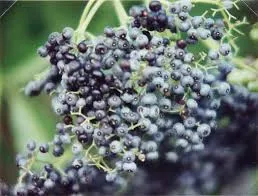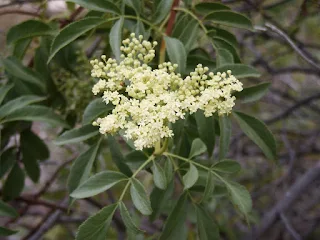By Liliana Usvat
Blog 352-365
A new study shows that fields bordered by native hedgerows had higher levels of pest-eating insects.
Planting flowers is no vanity. Not only does having a variety of blooms dotting the edges and uncultivated parts of a farm provide forage for bees and other pollinators, but it can reduce the amount of pesticides used on crops.
The reduction of crop pests such as aphids wrought by the predatory insects attracted by the hedgerows reached 200 meters into the fields.
Simply changing what grows along the edge of a field—which can also help control dust, erosion, and other issues—helped provide pest control for the entire crop.
Ceanothus, California buckwheat, and Mexican elderberry—are highly drought-tolerant and can likely survive on rainfall and a small amount of summer irrigation after becoming established.
Clearing field edges had no food-safety benefit and destroyed habitat for beneficial insects.
The introduction of native wildlife habitat in the midst of crop plantings has been found to help reduce runoff and curb erosion on corn belt farms.
This variety of California Buckwheat is the common one that grows in most of the populated areas of California and is hardy to 0 F(but a sustained freeze of days can kill it) and very drought tolerant. We've had customers remove rose bushes to plant this one as it has more flowers for longer with less care and watering.
Eriogonum fasciculatum var. foliolosum, California Buckwheat, has flowers, leaves and seeds that are all used by butterflies and small birds. White flowers come on in late spring, gradually turn pink in summer, then rust colored in fall. The rusty flowers commonly stay on until the next spring.
The buckwheats are very important butterfly plants and one of the pillars of their communities. California Buckwheat has a whole community of insects living with the flowers.
In a small garden you can set a couple feet away from this shrub (or sub-shrub) and watch 50 or maybe 100 insects interact at one time.
Eriogonum fasciculatum foliolosum tolerates sand and clay.
Eriogonum fasciculatum foliolosum is great for a bird garden and a butterfly garden.
Eriogonum fasciculatum foliolosum's foliage color is green and type is evergreen.
Eriogonum fasciculatum foliolosum's flower color is pink.
Mexican elderberry
Other Names Sambucus mexicana
Mexican elderberry or Tapiro,(Sambucus mexicana) is a deciduous shrub to tree with butter yellow flowers in Apr.-Aug. followed by purple berries in September-October. .
This elderberry is native to canyons, valleys west of Sierra Nevada form Oregon to Baja and east to West Texas. It likes full sun to part shade, garden water.
It will take extreme drought after it gets its roots down. There is a twisted old specimen south of Shandon growing out in full sun, the only plant left by cattle for miles in a 7"rainfall area. (It's surviving because its trunk twisted and the cattle rubbed all the bark off but didn't girdle it because of the twisting.) Its bluish-black berries are excellent in jelly, fair in pie. Pruning keeps the tree attractive.
Sambucus mexicana
Blog 352-365
A new study shows that fields bordered by native hedgerows had higher levels of pest-eating insects.
Planting flowers is no vanity. Not only does having a variety of blooms dotting the edges and uncultivated parts of a farm provide forage for bees and other pollinators, but it can reduce the amount of pesticides used on crops.
The reduction of crop pests such as aphids wrought by the predatory insects attracted by the hedgerows reached 200 meters into the fields.
Simply changing what grows along the edge of a field—which can also help control dust, erosion, and other issues—helped provide pest control for the entire crop.
Ceanothus, California buckwheat, and Mexican elderberry—are highly drought-tolerant and can likely survive on rainfall and a small amount of summer irrigation after becoming established.
Clearing field edges had no food-safety benefit and destroyed habitat for beneficial insects.
The introduction of native wildlife habitat in the midst of crop plantings has been found to help reduce runoff and curb erosion on corn belt farms.
Ceanothus concha
Other names Californian Lilac
An evergreen shrub
with foliage is glossy green with a resemblance to mint leaves. In
spring and summer, large blue panicles of flower emerge that make a
striking display.
Soil
A lighter soil type is
preferable, that is well drained. Keep well watered for best results
but they can withstand dry periods. N.B. quite salt resistant as well.
Diseases
Excess humidity can be a problem but root strain due to high winds will often kill off Ceanothus.
Maintenance
Note
these plants can be affected by overly warm or humid conditions and a
healthy plant has been known to keel over and die after a warm wet
summer. If you keep them sheltered from strong winds and give them
lots of sun then they should last a long time.
Comments
The name comes from Greek - sounds like blue
California buckwheat
Other Names
Eriogonum fasciculatum foliolosum
A low, spreading generally documented perennial shrub with 2-4 ft.
branches. There are four similar
subspecies recognized.
This variety of California Buckwheat is the common one that grows in most of the populated areas of California and is hardy to 0 F(but a sustained freeze of days can kill it) and very drought tolerant. We've had customers remove rose bushes to plant this one as it has more flowers for longer with less care and watering.
Eriogonum fasciculatum var. foliolosum, California Buckwheat, has flowers, leaves and seeds that are all used by butterflies and small birds. White flowers come on in late spring, gradually turn pink in summer, then rust colored in fall. The rusty flowers commonly stay on until the next spring.
The buckwheats are very important butterfly plants and one of the pillars of their communities. California Buckwheat has a whole community of insects living with the flowers.
In a small garden you can set a couple feet away from this shrub (or sub-shrub) and watch 50 or maybe 100 insects interact at one time.
Eriogonum fasciculatum foliolosum tolerates sand and clay.
Eriogonum fasciculatum foliolosum is great for a bird garden and a butterfly garden.
Eriogonum fasciculatum foliolosum's foliage color is green and type is evergreen.
Eriogonum fasciculatum foliolosum's flower color is pink.
Mexican elderberry
Other Names Sambucus mexicana
Mexican elderberry or Tapiro,(Sambucus mexicana) is a deciduous shrub to tree with butter yellow flowers in Apr.-Aug. followed by purple berries in September-October. .
This elderberry is native to canyons, valleys west of Sierra Nevada form Oregon to Baja and east to West Texas. It likes full sun to part shade, garden water.
It will take extreme drought after it gets its roots down. There is a twisted old specimen south of Shandon growing out in full sun, the only plant left by cattle for miles in a 7"rainfall area. (It's surviving because its trunk twisted and the cattle rubbed all the bark off but didn't girdle it because of the twisting.) Its bluish-black berries are excellent in jelly, fair in pie. Pruning keeps the tree attractive.
Sambucus mexicana
- tolerates clay and seasonal flooding
- is great for a bird garden
- foliage color is green and type is deciduous
- flower color is yellow
- fruit is edible.





